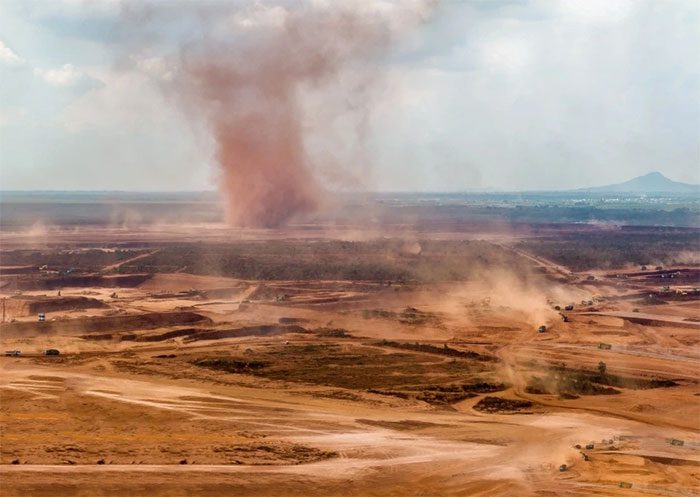Red dust contains soil particles and is not only a type of construction dust but also belongs to the group of air pollutants.
In an interview with a reporter, Dr. Nguyen Huu Hoang, a lecturer at the University of Medicine and Pharmacy in Ho Chi Minh City, stated that people living in environments with excessive dust are more likely to suffer from various respiratory diseases. Dust enters the lungs and can cause upper respiratory illnesses such as rhinitis, pharyngitis, and sinusitis.
Subsequently, it descends into the lungs, leading to lung damage. This condition can recur if individuals are exposed to dust pollution for extended periods.
“The composition of dust not only includes soil, but also various chemicals and metals, which can have long-lasting effects on the population, especially if they live in a dusty environment continuously,” Dr. Hoang noted.

Red dust at Long Thanh Airport construction site (Dong Nai) blown around by the wind. (Photo: Chi Hung).
For individuals with pre-existing conditions such as allergic rhinitis, chronic sinusitis, asthma, and chronic obstructive pulmonary disease (COPD), the situation can worsen.
If individuals with these conditions are exposed to dusty environments for long periods, they will find it increasingly difficult to control their symptoms, leading to a deterioration of their health.
Meanwhile, Dr. Nguyen Hai Cong, head of the Tuberculosis and Lung Diseases Department at Military Hospital 175 in Ho Chi Minh City, emphasized that direct contact with red dust on the skin, nose, or eyes can cause inflammation, skin infections, conjunctivitis, or rhinosinusitis, especially in individuals with sensitive skin prone to allergies.
This type of dirt also contains insoluble components such as asbestos, silica, or coal dust. When these particles enter the respiratory tract, they can settle and cause acute inflammation, which over time may lead to chronic inflammation and fibrosis of the airways.
Due to their small size and shape, red dust particles can easily penetrate the respiratory system, reaching the lung tissue and causing fibrosis or abrasions in the airways.
In children, the cilia, nasal hair, and mucus-producing glands are not fully developed; therefore, when dust penetrates deeply, it can lead to more severe inflammation.
“Red dust has a significant impact on public health, especially in dry weather, with little rain, low humidity, and strong winds,” Dr. Cong mentioned.
Difficulty in filtering fine dust particles
Regular masks can only filter out larger dust particles; some fine dust particles can still pass through and enter the lungs, causing coughing and phlegm, significantly affecting the respiratory system.
“The optimal solution is for people to leave areas with high levels of red dust or use air purifiers,” Dr. Hoang advised.
In light of the dangerous health effects of red dust, Dr. Nguyen Hai Cong recommends that people should take warm showers to clean their skin and mucous membranes after being outside. Additionally, they should gargle with saline solution and regularly rinse their noses or use nasal sprays to cleanse their airways.
Before going outside, everyone should take precautions to limit exposure to dust by covering up properly, such as wearing masks, goggles, and long-sleeved clothing.



















































